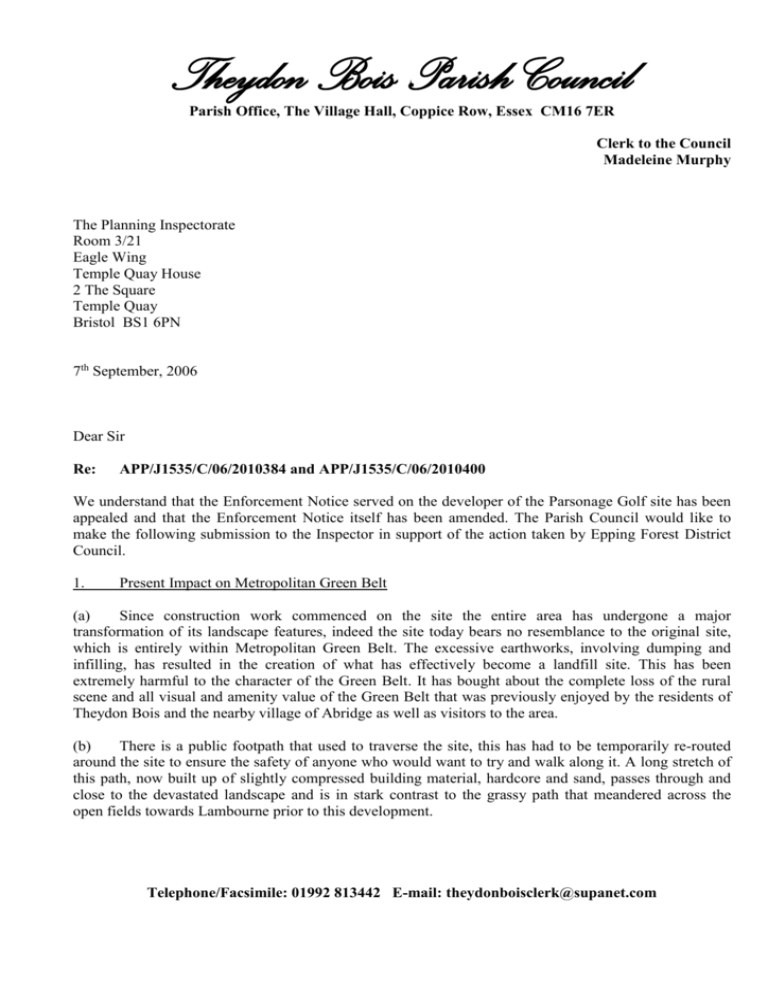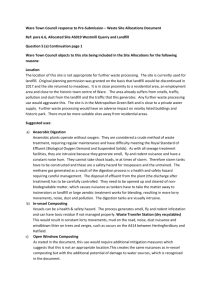Word Document - 50K - Theydon Bois Village Web Site
advertisement

Theydon Bois Parish Council Parish Office, The Village Hall, Coppice Row, Essex CM16 7ER Clerk to the Council Madeleine Murphy The Planning Inspectorate Room 3/21 Eagle Wing Temple Quay House 2 The Square Temple Quay Bristol BS1 6PN 7th September, 2006 Dear Sir Re: APP/J1535/C/06/2010384 and APP/J1535/C/06/2010400 We understand that the Enforcement Notice served on the developer of the Parsonage Golf site has been appealed and that the Enforcement Notice itself has been amended. The Parish Council would like to make the following submission to the Inspector in support of the action taken by Epping Forest District Council. 1. Present Impact on Metropolitan Green Belt (a) Since construction work commenced on the site the entire area has undergone a major transformation of its landscape features, indeed the site today bears no resemblance to the original site, which is entirely within Metropolitan Green Belt. The excessive earthworks, involving dumping and infilling, has resulted in the creation of what has effectively become a landfill site. This has been extremely harmful to the character of the Green Belt. It has bought about the complete loss of the rural scene and all visual and amenity value of the Green Belt that was previously enjoyed by the residents of Theydon Bois and the nearby village of Abridge as well as visitors to the area. (b) There is a public footpath that used to traverse the site, this has had to be temporarily re-routed around the site to ensure the safety of anyone who would want to try and walk along it. A long stretch of this path, now built up of slightly compressed building material, hardcore and sand, passes through and close to the devastated landscape and is in stark contrast to the grassy path that meandered across the open fields towards Lambourne prior to this development. Telephone/Facsimile: 01992 813442 E-mail: theydonboisclerk@supanet.com 2. (c) The proximity of the area to Theydon Bois station means it is a popular destination for people from further in towards London to travel to, in order to enjoy a walk in the country. Visitors and residents can no longer take a pleasurable walk across the fields and enjoy the very amenity the Green Belt was designed to provide. There are other vantage points within the parish that enjoyed views across these fields, which have been marred by the development. (d) The site is overlooked by several properties within the parish, for example Parsonage Farm and the properties along Coopersale Lane and from a slightly further distance some properties in Forest Drive and Dukes Avenue. From the information provided by the developers to EFDC in letters of 21 May 1999 and 14 June 1999, the residents of these properties would have expected a 2.5 year period of relatively substantial but limited landscaping earthworks to create the golf course involving lorry movements of 5-6 per hour. These movements were restricted by EFDC to between 7.30 a.m. and 5.30 pm. Monday to Friday. The EFDC Committee Minutes of 24 July 2003 refer to consideration of TBPC’s letter of 23 July 02 and TBPC’s concerns about ‘certain assumptions in the report to this meeting including references to the importation of materials onto the site.’ The minutes also again noted that ‘lorry movements in relation to the importation of material were expected to be in the order of a maximum of 6 per hour’.The reality for residents has been an increase in lorry movements over and above this estimate by such a vast extent that it has led to them suffering the continual noise of lorries, bulldozers and heavy earth moving vehicles which have systematically destroyed the landscape of rolling farmland which they previously overlooked. People chose to live in Theydon Bois because of the open character and rural nature of its environs and the fact that the village is surrounded by land designated as Green Belt and therefore protected by Green Belt legislation. The amenity the residents expected to enjoy has been most severely affected by the development, which appears to have developed into a much more intensive and extensive operation than was ever envisaged. 2. Avoidance of Further Lorry Movements (a) The commencement of construction heralded what can only be described as an onslaught of lorries transporting material to be dumped on the site. The number of lorries, which has been recorded on several occasions by residents and indicates regular movements in excess of 250 a day (see Appendix 6 of TBAAG Response), bears testament to the sheer extent of the operations. The route taken by the lorries passes directly by a number of properties in the parish and these residents have been most severely affected by continual nuisance and disruption from the noise, vibration and dust caused by the excessive lorry traffic levels. The significant increase in the number of heavy vehicles using the route would also have resulted in a higher level of pollution from the exhausts as well as contributing to the loss of the rural character of the area. (b) The Abridge Road is one of the four main roads in and out of the village of Theydon Bois and as such the lorry traffic movements cause nuisance and inconvenience to many other residents who drive and frequently use the road. The weight limit on the bridge crossing the railway at Theydon Bois means that prior to the construction work the route experienced very little heavy traffic making the increase even more apparent. The road leading from Abridge to Theydon Bois is a wide but bending road with a slow but steady uphill gradient. It is unlit and has no pavement along its route. Motorists do travel along this section at high speed and there have been several accidents over the years. The presence of the slow moving lorries have made this stretch even more dangerous. At the Abridge end of the road there is a narrow ancient bridge crossing the River Roding which does not accommodate two lanes of traffic when 3. a lorry is crossing. The bridge is immediately followed by a T junction. The level of lorry movements has significantly increased traffic congestion at this junction, particularly during ‘rush hour’ traffic leading to long queues and increased travel times for residents. (c) The lorries leave the site having crossed large areas of land covered in the local heavy clay. Despite wheel washing facilities being provided on the site any lorry departing from the site can be seen to be leaving a trail of clay behind them. In wet weather this soon produces a film of clay across the road that becomes a hazard to any driver forced to brake unexpectedly, the lorries themselves obviously cause a great deal of braking as they travel much slower then the rest of the traffic. Even in dry conditions there are hazards as the clay from the wheels quickly dries to dust which is unpleasant to drive through and soon covers the hedgerows which flank parts of the road. (d) The surface of the road has been severely damaged adding even further to the dangerous conditions. The Highways Agency were obviously concerned about the deteriorating condition and hazards caused by the lorries as they have erected yellow signs giving an advisory safe speed limit of 30 mph – the road is otherwise de-restricted with a 60mph limit applying. Frustratingly the Highways Agency will not repair the road until they are sure lorry movements have ceased. (e) The Parish Council feel it is imperative that no further large scale transportation of spoil to or from the site is allowed and the only permitted lorries should be those importing material deemed by the Inspector as essential to complete the construction of the golf course. 3. Work Done Does Not Constitute the Original Intention of the Planning Permission (a) The Parish Council is well aware of the original plans passed granting planning permission for an eighteen hole golf course and a subsequent permission for a clubhouse and associated facilities. The Council has been assured that this was the intention of the developer and looked forward to a time when the landscape, although altered in places, would again provide a pleasant country scene providing a rural backdrop for our village. However we have become increasingly concerned that this is simply not the case. (b) The original plans indicated the areas of land that would be raised in order to create an interesting course but sizeable areas were to be left untouched. Although clear restrictions on the amount of spoil needed to do this were not imposed the Planning Officers were only expecting importation of 140,000 cubic metres material (including gravel, sand and finishing materials) for contouring the Golf Course. The original plans also included a proposal for a landscape buffer zone requiring the importation of a further 275,000 cubic metres of material. The letter from Swan Golf Designs to EFDC of 14 June 1999 informs EFDC that the importation of the proposed 415,000 cubic metres of material will require 5-6 lorry movements per hour over a 30 month period. Subsequently, the landscape buffer zone proposal was revised and the required importation of material was reduced to 29,000 cubic metres. This substantial reduction in total volume from 415,000 cubic metres to 169,000 cubic metres would have allowed for the importation of materials to be comfortably completed within the original estimate of lorry movements. The number of lorry movements actually involved to date would indicate that the total volume of importation of materials has far exceeded the volume originally stated by the developers as being required. 4. (c) The entire area has been covered with a varied mixture that includes waste building materials and local opinion is that no part of the site has been raised less than 2m and some parts far in excess of this. We know Epping Forest District Council will present evidence to the Inquiry to show the true volume of spoil imported. But it is visually apparent to local residents that the material dumped on the site has raised the ground level by a significant amount, far greater than necessary to comply with the planning permission. (d) The developer has also excavated massive pits, some of which have already been infilled with spoil. We are aware it is normal practice in golf course construction to extract local clay to cap and contour the final shaping of the course. Although this is very understandable, we would question just how much clay is needed to cap the area. It appears that far more material has been excavated than is necessary and these pits have been excavated to such a depth they can have no primary purpose for construction of the proposed course to the levels for which planning permission was obtained. They seem to have a more apparent purpose of providing more space for infill materials to be dumped prior to further dumping above the previous ground level and incorporation into the site. Overall, we do question whether the activity on site is a genuine precursor to completion and implementation of the approved planning permission. We would ask the Inspector to uphold the Enforcement Notices and do everything in his power to ensure that a golf course is completed with the minimum possible disruption, so once again residents of Theydon Bois can enjoy the visual and recreational amenity of our surrounding countryside. Yours faithfully Robert Glozier Chairman Enclosures: TBPC 1. Letter from Swan Golf Designs to EFDC of 21/5/99 TBPC 2. Letter from Swan Golf Designs to EFDC of 14/6/99 TBPC 3. Letter from TBPC to EFDC of 23/7/03 TBPC 4. Statement in Support of Planning Application EPF765/1999 stamped by EFDC on 24.05.99 TBPC 5. EFDC Committee Minutes of Ad Hoc Special Meeting held on 24/7/03 TBPC 6. Appendix 6 of Theydon Bois and Abridge Action Group Response





